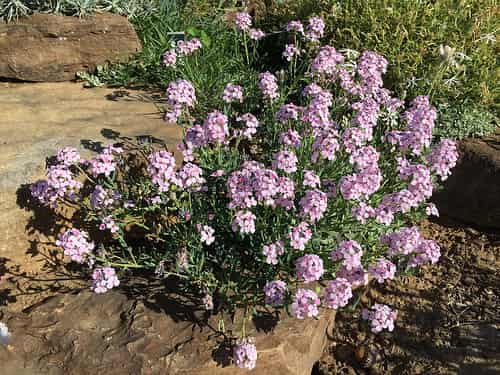Resource Library
Plant of the Week: Aethionema armenum Stonecress, Persian Candytuft
When I look at the diminutive stonecress growing in the rock garden, a tune always pops in my head. The Brazilian bossa nova classic from the 1960’s, The Girl from Ipanema, always cranks up because the Latin name of these little plants is Aethionema. This little mnemonic trick helps me remember its name, and if you have to have an ear worm, it may as well be a good one.
Aethionema is a genus of about 60 species of the mustard family native to the Mediterranean region, with about 40 of these found in Turkey. The ones that have found their way into rock gardens grow as dwarf evergreen subshrubs with a growth habit similar to candytuft (Iberis). They form woody bases with sprawling stems that are herbaceous at the tips.
The leaves are less than an inch long, linear in outline and usually grayish or blue-green in color and handsome when the plants are not in flower. Taller growing forms such as A. grandiflorum may reach 8 inches in height with a spread of twice that. A. armenum, the one I have found easiest to grow, is about 4 inches tall and forms a compact mound about 8 inches across.
Flowers are typical of the mustard family with four, pinkish petals forming the characteristic “+” sign when inspected closely. Individual flowers are less than a quarter inch across but packed onto a terminal scape that grows into a compact, rounded head an inch across. For me, bloom time is during late March through April. Warley Rose is a sterile hybrid and has a longer blooming period.
Warley Rose, the only Aethionema even remotely common in the American nursery trade — and even then, only available from rock garden specialists — owes its origins to a cantankerous English gardener, Ellen Willmott (1858-1934). She embarked on rock gardening in 1882, when this style of gardening first began. A woman of means, she employed as many as 100 gardeners at her peak, but was bankrupt when she died.
Miss Willmott’s garden at Warley Place was said, at the time of her death, to contain 100,000 distinct kinds of plants. She contributed to the expenses of plant explorers and was rewarded by offerings of new plants when they were first introduced and had several plants named after her. She was especially into roses and daffodil bulbs. As she got older and more crotchety, she even booby-trapped her daffodil plantings to deter bulb thieves.
Aethionema is easy to grow from seed and young transplants have better establishment rates than older plants. They should be grown in full sun locations in gritty, well drained neutral to alkaline soils. Because of the specific soil requirements, only a constructed rock garden soil should be used. I like one part compost or leaf mold to two parts builders sand. This can be supplemented with some quarter inch crushed limestone chips to improve drainage and provide the alkaline pH required.
Aethionemas are not especially long lived in the garden, so having some seedlings or easily rooted summer cuttings growing in pots is a good idea. If the site is to their liking, reseeding can occur.
For more information about horticulture or to see other Plant of the Week columns, visit Extension’s Website, www.uaex.uada.edu, or contact your county extension agent. The Cooperative Extension Service is part of the U of A Division of Agriculture.
Pursuant to 7 CFR § 15.3, the University of Arkansas System Division of Agriculture offers all its Extension and Research programs and services (including employment) without regard to race, color, sex, national origin, religion, age, disability, marital or veteran status, genetic information, sexual preference, pregnancy or any other legally protected status, and is an equal opportunity institution.
